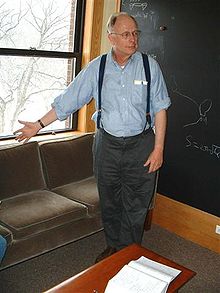| James B. Hartle | |
|---|---|
 Hartle in 2007 Hartle in 2007 | |
| Born | James Burkett Hartle (1939-08-17)August 17, 1939 Baltimore, Maryland, U.S. |
| Died | May 17, 2023(2023-05-17) (aged 83) Zurich, Switzerland |
| Alma mater | Princeton University California Institute of Technology |
| Known for | Consistent histories Hartle-Thorne metric Hartle-Hawking state |
| Scientific career | |
| Fields | General relativity Astrophysics Quantum mechanics |
| Institutions | University of California, Santa Barbara Santa Fe Institute |
| Doctoral advisor | Murray Gell-Mann |
James Burkett Hartle (August 17, 1939 – May 17, 2023) was an American theoretical physicist. He joined the faculty of the University of California, Santa Barbara in 1966, and was a member of the external faculty of the Santa Fe Institute. Hartle is known for his work in general relativity, astrophysics, and interpretation of quantum mechanics.
Early life
Hartle was born on August 17, 1939, in Baltimore to Anna Elizabeth Burkett and Charles James Hartle. He began as an engineering major upon entering Princeton, but switched to physics due to the influence of John Wheeler.
Hartle completed his AB at Princeton University in 1960 and his Ph.D. in particle physics under Murray Gell-Mann in 1964.
Work
In collaboration with Gell-Mann and others, Hartle developed an alternative to the standard Copenhagen interpretation, more general and appropriate to quantum cosmology, based on consistent histories.
With Dieter Brill in 1964, he discovered the Brill–Hartle geon, an approximate solution realizing Wheeler's suggestion of a hypothetical phenomenon in which a gravitational wave packet is confined to a compact region of spacetime by the gravitational attraction of its own field energy.
With Kip Thorne, Hartle derived from general relativity the laws of motion and precession of black holes and other relativistic bodies, including the influence of the coupling of their multipole moments to the spacetime curvature of nearby objects, as well as writing down the Hartle–Thorne metric, an approximate solution which describes the exterior of a slowly and rigidly rotating, stationary and axially symmetric body.
Working at the Enrico Fermi Institute at the University of Chicago in 1983, he developed the Hartle–Hawking wavefunction of the Universe in collaboration with Stephen Hawking. This specific solution to the Wheeler–deWitt equation is meant to explain the initial conditions of the Big Bang cosmology.
Hartle's textbook on general relativity, Gravity: An Introduction to Einstein's General Relativity, was published in 2003. It has been praised for its lucid explanations and focus on physical insight rather than mathematical details.
Hartle was a founder of the Kavli Institute for Theoretical Physics and served as its director from 1995 to 1997.
He was elected to the American Philosophical Society in 2016. He also was an American Physical Society Fellow, a Guggenheim Fellow, and was elected to the National Academy of Sciences. He received the 2009 APS Einstein Prize for his "broad range of fundamental contributions to relativistic stars, quantum fields in curved spacetime, and especially quantum cosmology."
Personal life
Hartle married Mary Jo Wheeler in 1984, the niece of John Wheeler.
Hartle was diagnosed with Alzheimer's disease in 2022. He died in Zurich, Switzerland on May 17, 2023, at the age of 83.
References
- ^ Garisto, Dan (June 15, 2023). "Jim Hartle, 1939-2023". APS News. American Physical Society. Retrieved August 10, 2023.
- Brill, D. R.; Hartle, J. B. (1964). "Method of the Self-Consistent Field in General Relativity and its Application to the Gravitational Geon". Phys. Rev. 135 (1B): B271 – B278. Bibcode:1964PhRv..135..271B. doi:10.1103/PhysRev.135.B271.
- Hartle, James; Thorne, Kip S. (1985). "Laws of motion and precession for black holes and other bodies" (PDF). Physical Review D. 31 (8): 1815–1837. Bibcode:1985PhRvD..31.1815T. doi:10.1103/PhysRevD.31.1815. PMID 9955908.
- Hartle, James B. (2003). Gravity: an Introduction to Einstein's General Relativity. San Francisco: Addison–Wesley. ISBN 0-8053-8662-9.
- "2009 Einstein Prize Recipient". www.aps.org. Retrieved August 21, 2023.
- "In Memoriam: James Hartle | Santa Fe Institute". www.santafe.edu. June 2, 2023. Retrieved August 21, 2023.
- "APS Member History". search.amphilsoc.org. Retrieved February 18, 2021.
- "Jim Hartle Obituary". Department of Physics, University of California, Santa Barbara. Archived from the original on June 4, 2023. Retrieved May 31, 2023.
- "In Memoriam: James Hartle | Santa Fe Institute". www.santafe.edu. June 2, 2023. Retrieved March 25, 2024.
External links
- James Hartle homepage Archived July 25, 2011, at the Wayback Machine
- Faculty profile
- "The Future of Gravity" – April 2000 online lecture (RealAudio plus slides)
- "Spacetime Quantum Mechanics" online RealAudio lecture
- "The Classical Behavior of Quantum Universes" online RealAudio lecture
- James Hartle at the Mathematics Genealogy Project
- "The Quantum Universe: Essays on Quantum Mechanics, Quantum Cosmology, and Physics in General" book (World Scientific, 2021)
- 1939 births
- 2023 deaths
- 20th-century American physicists
- 21st-century American physicists
- American relativity theorists
- American textbook writers
- American male non-fiction writers
- California Institute of Technology alumni
- University of California, Santa Barbara faculty
- Members of the United States National Academy of Sciences
- Santa Fe Institute people
- Members of the American Philosophical Society
- Fellows of the American Academy of Arts and Sciences
- Fellows of the American Physical Society
- Sloan Research Fellows
- Scientists from Baltimore